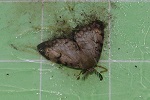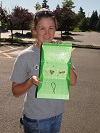WSDA normally places about 20,000 spongy moth traps throughout the state each year. Traps are used for detecting the presence of moths and are not normally used for eradication. Only caterpillars inflict damage to vegetation. Since the traps attract only the adult males, traps placed near residences do not represent any increased threat of damage by spongy moth to homeowners.

Traps are constructed of colored cardboard. They are usually green, tan, or orange. The inside of the trap is coated with a sticky substance that ensnares insects when they land or crawl inside the trap. A lure, composed of string coated with a synthetic pheromone, is also placed inside the trap. A pheromone is a substance emitted by females to attract males during mating. Males searching for females are drawn by the scent of the pheromone and become stuck to the sticky substance inside of the trap.


WSDA crews check traps for spongy moths every few weeks during the flight season (June to September). Once a spongy moth is caught, the number and location of the trap is recorded and the specimen is sent to a lab for identification. Data from WSDA's spongy moth trapping program are incorporated in a national database of spongy moth information.
